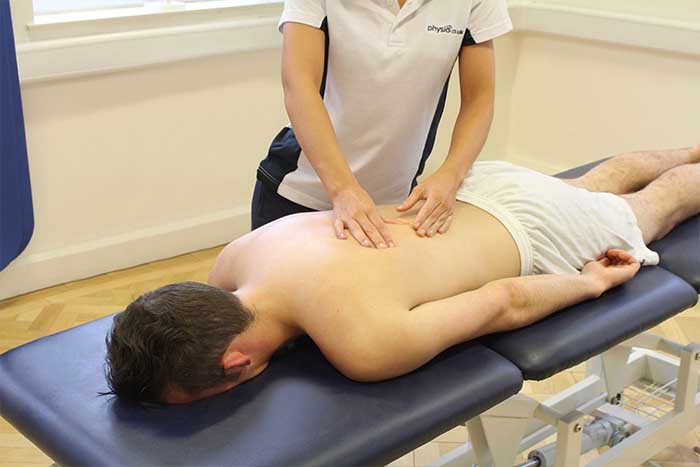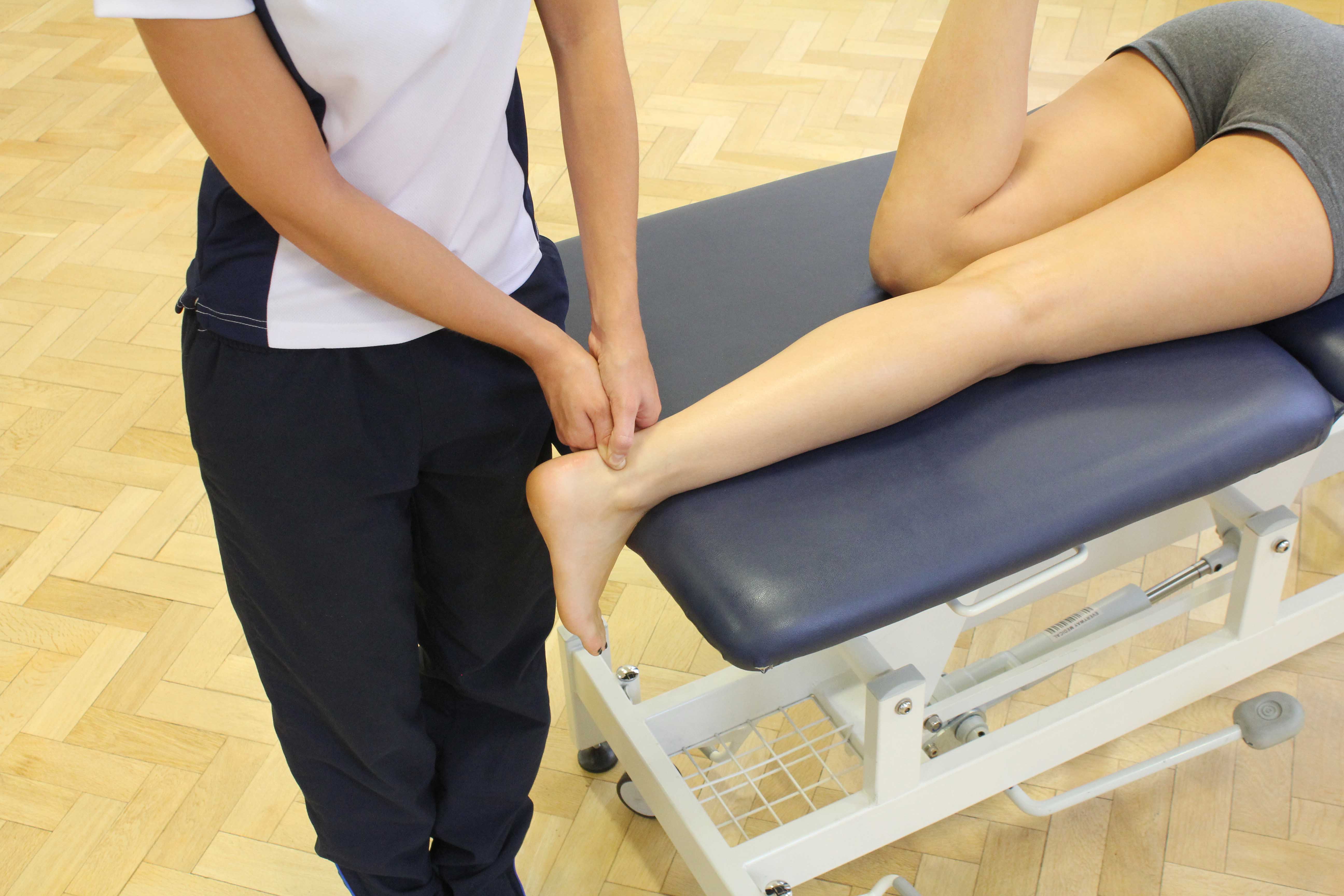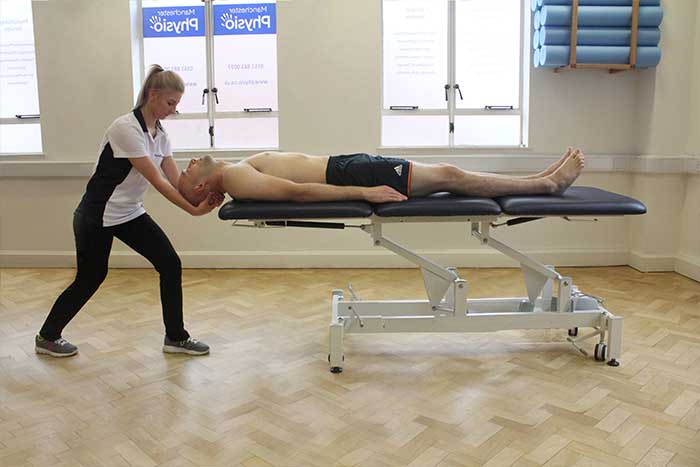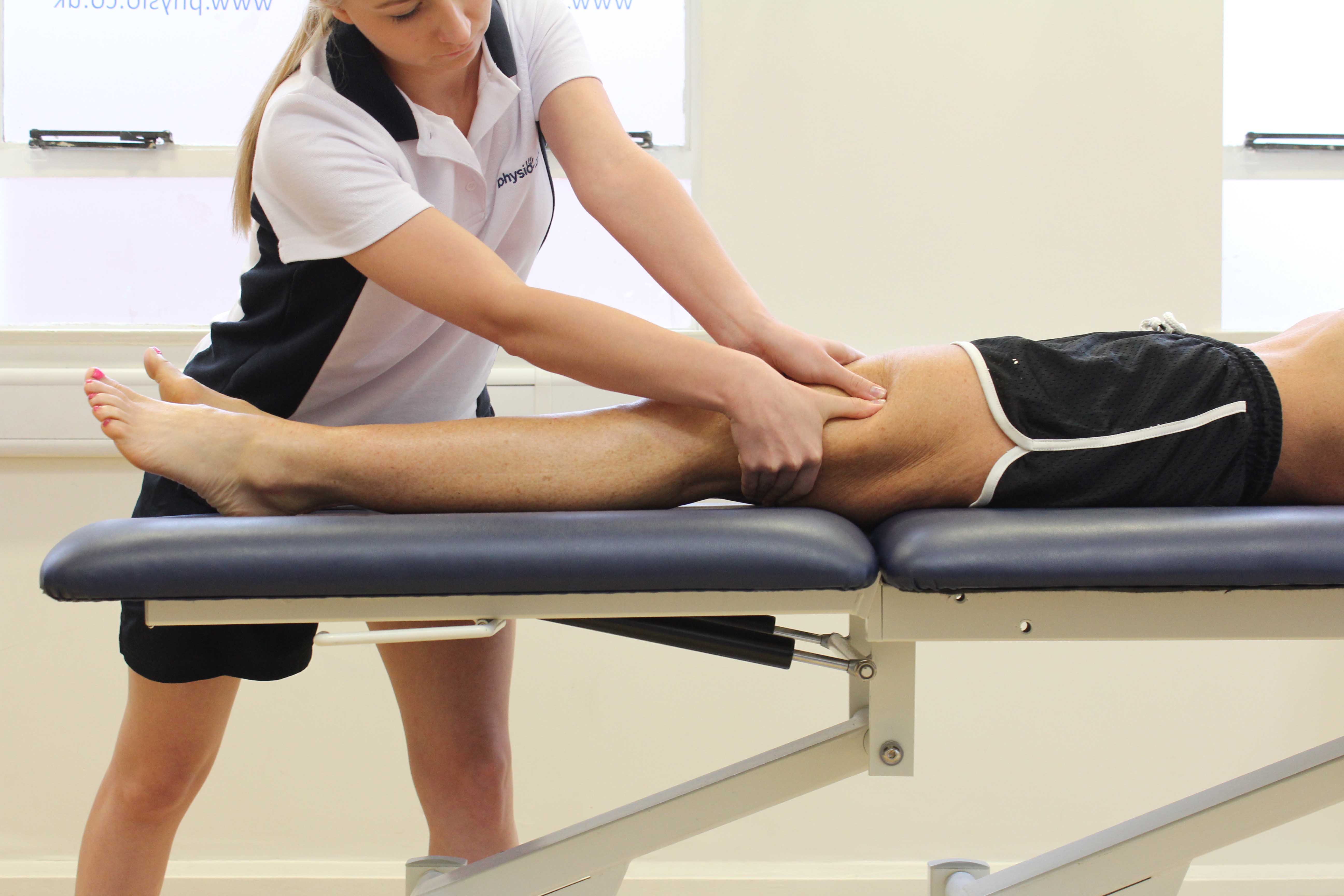The breakdown of scar tissue is a common benefit gained through massage. Scar tissue is made up of collagen fibres. Collagen fibres are fibrous connective tissues that have many functions within the body. The main function of collagen fibres within scar tissue is for the repair of damaged fibres within the body. Scar tissue can become very restrictive as the elasticity of the tissues is smaller than the body's natural muscular tissues. Our massage therapists at Physio.co.uk use break down scar tissue through massage to help decrease pain, increase range of movement and relieve restriction.

What are the most appropriate types of massage to break down scar tissue?
There are a variety of different types of massage that can be used to break down scar tissue. The most appropriate massages used include:
 Above: Transverse friction massage to achilles tendon
Above: Transverse friction massage to achilles tendonThe most appropriate types of massage used to breakdown scar tissue include sports massage, deep tissue massage and remedial massage.
Sports massage is used to break down scar tissue. A sports massage mainly focuses on areas containing soft tissues. Sports massage can vary in pressure depending on personal preference. The breakdown of scar tissue occurs during a sports massage as an increase in temperature of the scar tissue is encouraged. An increase in temperature helps the scar tissue to loosen and be broken down more easily. A variety of techniques are used within a sports massage aiming to breakdown scar tissue, decrease pain and increase relaxation.
Scar tissue is broken down within a deep tissue massage. A deep, firm pressure is used during a deep tissue massage aiming to get deeper within muscle fibres and tissues. A deep tissue massage breaks down adhesions and collagen fibres that can be caused as a result of scar tissue. Adhesions restrict movement and increase pain resulting in an increase in stress. Breaking down scar tissue through deep tissue massage relieves restriction to decrease pain and reduce stress.
What techniques are used to break down scar tissue?
A wide range of techniques can be used to break down scar tissue. The most common techniques used include:
The most common techniques used to breakdown scar tissue include acupressure, frictions and trigger pointing.
Acupressure is a common technique used to break down scar tissue. Acupressure is performed using finger tips and thumbs and is where pressure is applied to both acupressure and trigger points located on specific areas of the body. When pressure is applied to the specific acupressure or trigger points, blood flow is restricted resulting in an ischemic reaction. An ischemic reaction is where blood flow is restricted to specific areas and when pressure is released, the flow is increased. As the pressure is applied, scar tissue is softened and broken down. As the pressure is released, an increase in blood flow occurs to help repair damage and improve the muscles condition.
Frictions are often used to break down scar tissue. Frictions involve applying pressure along muscle fibres using the fingertips or thumbs. Frictions are used on dry skin and help to break down built up bundles of collagen fibres. A build-up of collagen fibres are formed as a result of scar tissue. Frictions increase the temperature of muscles, helping to loosen and break down the collagen fibres. Breaking down collagen fibres reduces the amount of scar tissue within muscles resulting in a decrease in restriction and pain and an increase in range of movement and relaxation.
Scar tissue can be broken down using trigger pointing. Trigger pointing is where a specific pressure is placed on trigger points. Trigger points are neuromuscular points found in centre of a muscle fibre. The meeting of a nerve and muscle is where neuromuscular points are found and can often become painful when compressed. The length of time pressure is applied to trigger points can vary. As pressure is applied, scar tissue is broken down and a numbing sensation will occur. When the numbing sensation occurs, an increase in pressure can be applied to get deeper into the scar tissue. Once pressure has been released, an increase in blood flow occurs to repair damaged tissues.

When can a massage help to break down scar tissue?
A massage can help to break down scar tissue in many situations. Common situations the breakdown of scar tissue can help through massage include:
 Above: Deep tissue massage of vastus lateralis and illio-tibial band
Above: Deep tissue massage of vastus lateralis and illio-tibial bandThe most common situations a massage can help to break down scar tissue include acute pain, post-surgery and scarring.
A massage can reduce acute pain by breaking down scar tissue. A buildup of scar tissue causes restriction that increases pain. During a massage an increase in blood flow occurs, rising the temperature of muscles and tissues. A rise in temperature decreases tissue inelasticity of tissues decreasing restriction and allows the scar tissue to be broken down more easily. A decrease in restriction caused by scar tissue increases range of movement and relieves pain.
A massage can help to break down scar tissue post-surgery. After surgery, a buildup of scar tissue occurs to help repair damaged muscle fibres and tissues. Scar tissue is not as elastic or flexible as the body's natural muscle fibres so movement can be limited and pain can increase, worsening the effects of surgery. During a massage, temperature of scar tissue is increased to help improve the tissue elasticity and flexibility. Increasing the elasticity and flexibility allows the scar tissue to be broken down more easily. Previously limited movement is reduced and pain decreases as elasticity improves and scar tissue is broken down.
Scarring can be reduced when scar tissue is broken down through massage. Scarring occurs for a variety of reasons. The most common causes of scarring is injury and surgery. Scarring can affect a person both physically and psychologically. The scar tissue that makes up the scars is often restrictive and can increase pain, physically affecting a person. Scarring also has a different coloured appearance to a person's normal skin due to the haphazard positions collagen fibres are laid, affecting a person psychologically. A variety of techniques are used to increase the temperature of scar tissue to help to loosen and break down the fibres. Once the scar tissue has been loosened and broken down, the collagen fibres making up the scar tissue is realigned. Loosening and breaking down the scar tissue helps to reduce restriction and realigning the collagen fibres helps to reduce their appearance.
What are the physiological effects of massage to break down scar tissue?
There are various physiological effects of massage to break down scar tissue. The most common physiological effects that occur include:
The most common physiological effects that occur to break down scar tissue include increased temperature, increased oxygenation and the breakdown/realignment of collagen fibres.
Increased temperature is a common physiological effect that helps to break down scar tissue. Increased temperature involves both superficial and deep tissues increasing in temperature. Increasing temperature of tissues within the body helps to loosen scar tissue. Temperature is increased by the encouragement of improved circulation. Loosened scar tissue makes it easier for it to be broken down as elasticity and flexibility of the tissues is increased. Breaking down scar tissue by increasing temperature helps to relieve restriction and decrease muscle tightness.
A physiological effect that helps break down scar tissue is increased oxygenation. Increased oxygenation is where blood flow increases to supply muscles and tissues with an increase in oxygen. Oxygenation is increased when vasodilation and capillarisation occurs to help improve blood circulation. Vasodilation is where blood vessels widen and become closer to the surface of the skin, allowing an increase in blood to travel through them. Capillarisation is where an increase in capillaries surround a muscle, increasing the availability of oxygen and nutrients. Increasing oxygenation helps to break down scar tissue as it helps to repair damaged cells can also provide the muscle with energy for the healing process.
The breakdown/realignment of collagen fibres is a physiological effect of massage to break down scar tissue. Collagen fibres are fibrous connective tissues that make up scar tissue. Collagen fibres that make up the scar tissue are used to repair damaged tissues resulting in the formation of adhesions. Adhesions are formed when collagen fibres lay haphazardly across muscle fibres and fascia. The haphazard position collagen fibres are laid in, cause a restriction in movement and can increase pain. Breaking down and realigning collagen fibres helps to break down scar tissue. During a massage the cross link formed between collagen fibres are broken down. A variety of techniques are then used to re align the collagen fibres so they are in line with the body's natural muscle fibres. Once realigned, restriction is reduced and pain is relieved.
Summary
The breakdown of scar tissue involves breaking down and realigning collagen fibres that have built up within muscles. There are various types of massage that can be used to break down scar tissue including sports massage and deep tissue massage. Many techniques are used within massage including acupressure, frictions and trigger pointing all aiming to break down scar tissue. The breakdown of scar tissue can help in a wide range of situations including acute pain, post-surgery and scarring. There are also a variety of physiological effects of massage that occur to break down scar tissue including increased temperature, increased oxygenation and the breakdown/realignment of collagen fibres. Our massage therapists at Physio.co.uk breakdown scar tissue through massage to help increase relaxation and reduce restriction.
How can I arrange a massage to break down scar tissue?
To arrange a massage to break down scar tissue at Physio.co.uk, email us at office@manchesterphysio.co.uk or call us on 0161 883 0077.
You can also book an appointment online and save £10

 0330 088 7800
0330 088 7800


































